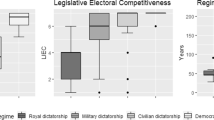Abstract
The literature suggests that democracy positively affects environmental policy stringency. Using the method of propensity score matching, we find that this result appears to be largely driven by the parliamentary democracies (as opposed to the presidential-congressional, proportional or majority systems). Moreover, it appears that presidential-congressional systems often set environmental policies not significantly different from autocracies. These are novel contributions to the literature.
Similar content being viewed by others
References
Baron, D.P. (1998). Comparative dynamics of parliamentary systems. American Political Science Review, 92, 593–609.
Center for International Earth Science Information Network (CIESIN) ( 2002). 2002 Environmental Sustainability Index. Yale Center for Environmental Law and Policy, Yale University.
Central Intelligence Agency (CIA) ( 2003). The World Factbook 2003. http://www.cia.gov/cia/publications/factbook/ index.html.
Chernick, M.R. (1999). Bootstrap methods: A Practitioner' guide. John Wiley and Sons Inc.: New York.
Congleton, R.D. (1992). Political institutions and pollution control. Review of Economics and Statistics, 74(3), 412–421.
Congleton, R.D. (Ed.). (1996). The political economy of environmental protection. Ann Arbor: University of Michigan Press.
Dehejia, R.H., & Wahba, S. (2002). Propensity score matching for nonexperimental casual studies. Review of Economics and Statistics, 84, 151–161.
Diermeier, D., Eraslan, H., & Merlo, A.M. (2006). The effects of constitutions on coalition governments in parliamentary democracies. In: R. Congleton, & B. Swedenborg (Eds.), Democratic Constitutional Design and Public Policy. Analysis and Evidence. Cambridge: MIT Press.
Diermeier, D., & Feddersen T.J. (1998). Cohesion in legislatures and the vote of confidence procedure. American Political Science Review, 92, 611–621.
Diermeier, D., & Merlo A. (2000). Government turnover in parliamentary democracies. Journal of Economic Theory, 94, 46–79.
Farzin, Y.H., & Bond, C.A. ( 2005). Democracy and environmental quality. Forthcoming, Journal of Development Economics.
Fredriksson, P.G., & Gaston, N. (2000). Ratification of the 1992 climate change convention: What determines legislative delay? Public Choice, 104, 345–368.
Fredriksson, P.G., & Millimet, D.L. (2004a). Comparative politics and environmental taxation. Journal of Environmental Economics and Management, 48, 705–722.
Fredriksson, P.G., & Millimet, D.L. (2004b). Electoral rules and environmental policy. Economics Letters, 84, 237–244.
Fredriksson, P.G., Neumayer, E., Damania, R., & Gates, S. (2005). Environmentalism, democracy, and pollution control. Journal of Environmental Economics and Management, 49, 343–365.
Freedom House ( 2003). Freedom in the World. http://www.freedomhouse.org.
Heckman, J.J., Ichimura, H., & Todd, P.E. (1997). Matching as an econometric evaluation estimator: evidence from evaluating a job training program. Review of Economic Studies, 64, 605–654.
Huber, J. (1996). The vote of confidence in parliamentary democracies. American Political Science Review, 90, 269–282.
Lundell, K., & Karvonen, L. (2003). A Comparative Data Set of Political Institutions. Department of Political Science, Abo Academy.
Lupia, A., & Strom, K. (1995). Coalitions and cabinet governments. American Political Science Review, 84, 873–890.
McGuire, M.C., & Olson, M., Jr. (1996). The economics of autocracy and majority rule: The invisible hand and the use of force. Journal of Economic Literature, 34, 72–96.
Metschies, G. ( 2003). International Fuel Prices. 3rd Edition, Eschborn, Germany: Deutsche Gesellschaft för Technische Zusammenarbeit GmbH (GTZ), http://www.zietlow.com/docs/Fuel-Prices-2003.pdf.
Milesi-Feretti, G.M., Perotti, R., & Rostagno, M. (2002). Electoral systems and public spending. Quarterly Journal of Economics, 117, 609–657.
Murdoch, J.C., & Sandler, T. (1997). The voluntary provision of a public good: The case of reduced CFC emissions and the montreal protocol. Journal of Public Economics, 63(3), 331–349.
Murdoch, J.C., Sandler, T., & Sargent, K. (1997). A tale of two collectives: sulphur versus nitrogen oxides emission reduction in Europe. Economica, 64(254), 281–301.
Neumayer, E. (2002a). Do democracies exhibit stronger international environmental commitment? A cross-country analysis. Journal of Peace Research, 39(2), 139–164.
Neumayer, E. (2002b). Does trade openness promote multilateral environmental cooperation? World Economy, 25(6), 815–832.
OECD/IEA (2000). Energy policies of IEA countries, 2000 Review. Paris: Organization for Economic Cooperation and Development and International Energy Agency.
Persson, T., Roland, G., & Tabellini, G. (2000). Comparative politics and public finance. Journal of Political Economy, 108, 1121–1161.
Persson, T., & Tabellini, G. (1999). Political economics and macroeconomic policy. In: Taylor, J. & Woodford, M. (Eds.), Handbook of macroeconomics. Amsterdam: North-Holland.
Persson, T., & Tabellini, G. (2002). Do constitutions cause large governments? Quasi-experimental evidence. European Economic Review, 43, 699–735.
Persson, T., & Tabellini, G. (2003). The economic effects of constitutions. Cambridge: MIT Press.
Rosenbaum, P., & Rubin, D. (1983). The central role of propensity score in observational studies for causal effects. Biometrika, 70, 41–55.
Warwick, P. (1994). Government survival in parliamentary democracies. Cambridge: Cambridge University Press.
World Bank (2003). World Development Indicators 2003. CD Rom. The World Bank, Washington, DC.
Author information
Authors and Affiliations
Corresponding author
Additional information
JEL Codes: D7, H1, Q28
Rights and permissions
About this article
Cite this article
Fredriksson, P.G., Wollscheid, J.R. Democratic institutions versus autocratic regimes: The case of environmental policy. Public Choice 130, 381–393 (2007). https://doi.org/10.1007/s11127-006-9093-1
Received:
Accepted:
Published:
Issue Date:
DOI: https://doi.org/10.1007/s11127-006-9093-1




